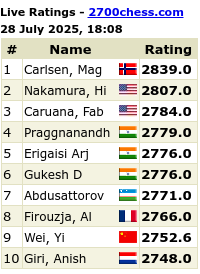The Blackmar–Diemer Gambit arose as a development of the earlier Blackmar Gambit, named after Armand Blackmar, a relatively little-known New Orleans player of the late 19th century who popularized its characteristic moves (1.d4 d5 2.e4 dxe4 3.f3) and was the first player to publish analysis on the opening in the chess literature."
Here are some lines in the Blackmar-Diemer Gambit ... This is very sharp and although White is said to have the advantage with the passed a-pawn, I expect it's still quite difficult to convert for White!
As usual - any comments welcome!!
1. d4 d5 2. e4?! This is the start of the Blackmar–Diemer Gambit. 2... dxe4 3. Nc3 Nf6 4. f3 exf3 5.Nxf3 is normal here but by capturing with the queen White lays a trap - Ryder Gambit. 5. Qxf3?! Qxd4 6. Be3 Qb4?! Better is 6...Qg4 Black thinks that castling is prevented because of ...Bg4 but White castles anyway. 7. O-O-O Bg4?? Walking into the trap. 8. Nb5!! After 8... Qc5 White threatens mate with 9.Nxc7#. The Black queen cannot capture the knight because 8...Qxb5 9.Bxb5+ is check and loses the queen. 8... Na6 9. Qxb7 Qe4 Black lost quickly in Diemer–Halosar, Baden-Baden 1934, after 9...Rc8 10.Qxa6 1-0. 10. Qxa6 Qxe3+ Worse is 10...Bxd1 11.Kxd1 Rd8+ 12.Bd2 and White is winning, for example 12...Ng4 13.Nxc7+ Kd7 14.Qxa7. 11. Kb1 Qc5 12. Nf3 The White threat of 13.Qb7 wins the black a-pawn by force. With even material and a passed a-pawn, White will have a winning advantage. Even stronger seems 12. Qb7! with the idea 12. ... Bxd1 13. Qxa8+ Kd7 14. Nc3 and White has a winning attack. 1-0
PGN Viewer courtesy of http://chesstempo.com/













No comments:
Post a Comment